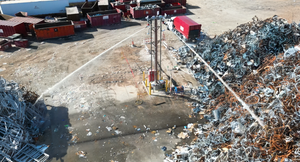Key Takeaways from the 2016 State of Curbside Report
The report features data from more than 400 municipal recycling programs in the U.S. And topics highlighted include frequency of collection, container type, municipal solid waste tip fees, material mix, collection approach and program ownership.
The United States Environmental Protection Agency (EPA) and national nonprofit The Recycling Partnership released the 2016 State of Curbside Report, which provides insight and analysis of key curbside attributes that influence the performance of recovering household recyclables at the curb.
The report features data from more than 400 municipal recycling programs in the U.S. And topics highlighted include frequency of collection, container type, municipal solid waste tip fees, material mix, collection approach and program ownership.
“The EPA is working to support communities as they make the transition to sustainable materials management. The insights from this research and analysis will allow us to more tightly target our resource allocation to that end,” said Jon Johnston of EPA Region 4, chief, materials and waste management branch. “We are very pleased with the depth and breadth of this report, as it shines a bright light on areas of opportunity that EPA can start supporting and the pathway to tangible progress.”
With this report, the EPA and The Recycling Partnership provide a clear overview of why some programs perform better than others and why strategic changes are needed to move forward with a circular economy and holistic sustainable materials management approach.
“Entering into this research, our goal was to simply evaluate common attributes of high-performing programs, but the findings go far beyond that,” said Cody Marshall, technical assistance lead for The Recycling Partnership, in a press release. “Recent research by the State of North Carolina’s Department of Environmental Quality shows that there is roughly 800 to 1,000 pounds of recyclables available in the household each year. There are great opportunities to recover more of that material across the country. This curbside report points to strategies that lead to higher recovery and clearly more resources need to be made available to local governments to unlock their full potential.”
Here are some key takeaways from the report:
The current state of U.S. curbside recycling in 2016 is stronger is some places compared to others. And residential curbside recycling is the most convenient and effective way to capture bottles, cans, containers and paper from residences.
U.S. curbside recycling systems share three common trends: strong community engagement leads to recovery in the home; a lack of consistency in how communities educate community members about curbside recycling programs leads to confusion and frustration; and no single characteristic can be changed to allow a struggling program to transform into a best-in-class program.
Out of the 465 cities featured in this study, 82 percent of the curbside-collected cities have single stream collection and 54 percent of the curbside-collected cities have weekly collection. Additionally, $47 is the national municipal solid waste (MSW) tip fee average and 357 is the average amount of pounds per household per year (lbs/hh/yr).
The 465 cities represented in this study include at least three incorporated areas in each state, besides Alaska and Hawaii; 250 of the largest, most-populous cities in the country; and each state capital. Additionally, at least 20 percent of the homes eligible for curbside recycling service are represented in each of the 10 EPA Regions; 28 percent of the homes in the U.S. that could potentially receive curbside recycling service are included; and a selection of communities relative of the diversity of curbside programmatic attributes are featured.
Waste characterizations and recovery rate studies have shown that S. households annually generate between 800 and 1,000 pounds of recyclables that would be placed in recycling containers.
Sixty-one percent of the cities in the report utilize curbside carts, making it the most predominant collection method in seven of the 10 EPA Regions.
The difference between weekly curbside collection and every-other-week curbside collection was small, with the average recyclables collected weekly comes to 366 lbs./hh/yr and the average recyclables collected every amounts to 362 lbs./hh/yr.
The different in amount of recyclables collected by either public or private entities via contract or subscription was also minimal, with the average recyclables collected by private haulers amounts to 371 lbs./hh/yr and the average recyclables collected by public haulers comes to 345 lbs./hh/yr.
While there appears to be no correlation to effective collection of recyclables and whether the material was collected by public or private entities, there is a correlation between the amount of materials recovered and how the systems are both established and managed.
The majority of the highest-performing curbside recycling programs collect material single stream, collect curbside recycling automatically, use an automated cart-based system and have public engagement that influences curbside recycling to occur in communities.
Of the top-performing communities featured in the report, 96 percent have single stream collection; 83 percent provide wheeled carts with lids to collect recyclables; and 93 percent provide automated collections services.
To boost curbside recycling performance, communities can encourage public action by triggering an action to incentivize recycling, provide local-level information, create simple and consistent programmatic measurement protocols and reporting and support broader areas of collection.
About the Author
You May Also Like




.png?width=300&auto=webp&quality=80&disable=upscale)